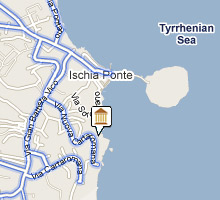Descrizione
The Torre di Michelangelo is the symbol of Ischia, along with the Castello. It majestically rises in front of the Castello, immersed in an immense green field, a few meters away from the very famous “Scogli di S. Anna” (The Saint Anna rocks).The Torre di Guevara (commonly called the ‘Torre di Michelangelo’ or the ‘Torre di S. Anna’) is a many-towered house built on the eastern stretch of the island’s coast which looks upon the Castello (the natural result of telluric commotion dating back to the 2nd century A.D.which was completely fortified by Alfonso d’Aragona in 1433 when he pre-arranged and solicited with an organized measure the construction of towers along stretches of the adjacent coast so as to protect the little island).
Within the context of serving as a building for defence, the Torre di Guevara was also a house-fortress, the owners being the Guevara family—dukes of Bovino—right up until the early 1800s. Butof Vittoria Colonna on the Castello d’Ischia and Michelangelo’s friendship with the noble castle-dweller have recently substantiated, along with the unfounded belief that Michelangelo had sojourned in the Torre Guevara (an ideal stationing for a ‘loving correspondence’ with his lover), a new, improper name for the building: the Torre di Michelangelo. In fact, in an attempt to confirm the presence of Michelangelo’s presence in Ischia this name has obscured another toponymy— an accredited one—theTorre di S. Anna", This name is due to the presence of a little church dedicated to Sant’Anna on this very site. The Torre di S.Anna was the designation used when the Guevara family abandoned the building. In fact, Torre di S.Anna was also the name used throughout the cartography of the 1800s.
Gina Algranati is the historian who attributed the building of the Torre di Guevara to Guevara, who arrived from Spain after Alfonso I d’Aragona. Alfonso I d’Aragona made him the ‘king’s knight’ in 1454. It is possible that it wasn’t until the end of the 15th century that construction of the tower began. During this time another member of the same familydon Francesco de Guevara ‘was no longer able to serve in the military’ and was therefore made a life-long governor of the Island of Ischia by Carlo V. One is also able to speculate the date of construction especially when considering the manneristic culture of the time period evidenced in the tower’s affrescos and its conception as a house-garden in the context of a place for mythical images and cultural metaphors.
In factthe tower was originally immersed in a garden of delights which licked up as a valley the waters of Cartaromana and those of a spring (no longer in use) that was exalted by Boccaccio. It was enclosed on two sides by high walls made of volcanic rock, a few stretches of which still stand today. The garden then continued higher up along half the coast with various cultivations and terminated before a little woodlot of thick tree vegetation. The scholarly imagery of the organized composition of the space covered by the tower-garden (an imagery that aimed at realizing a great natural metaphor opposite the constructed Castello) was completely compromised first by making agricultural use of the land and then by construction developments and terrible works of ‘restoration’ to property. Nonetheless, today, in spite of such threats, confirmation of the way the tower-garden used to look is represented in the great affresco that covers the pavilion vault of the south-west room of the tower’s main floor (piano nobile). Here, in the circle of a heraldic-chivalrous figuration, is a precious section dedicated to the original positions of places on the island as well as the original plans for international development.
The building is composed of three levels above the ground, the first floor having a scarp wall which ends with a bull made of live rock. The tower has a square layout and its geometry consists of openings bordered with texture weavings made of thick volcanic rock; this contributes to its accent of marked and intentional sobriety that translates into an image of refined and sophisticated elegance. It has become known as a significant work of the Neapolitan Renaissance..
Edited by Ilia Delizia
Info
Via Nuova Cartaromana.
Currently used as a multipurpose facility for exhibitions and events of special interest tourism.
Hosts throughout the year, interesting art exhibitions.
Closing day: Monday
Tel.: --
Bus lines: C12 - C13
Services
![]() Vicino al mare
Vicino al mare![]() Parcheggio
Parcheggio![]() Panoramico
Panoramico![]() Attività didattiche
Attività didattiche
Nelle Vicinanze
Hotel Da MariaHotel Parco Cartaromana
Porto di Ischia
Chiesetta di Sant' Anna
Chiesa di San Domenico
Baia di Cartaromana
Borgo di Celso
Galleria Ielasi
Il Museo del Mare
Il Museo delle Armi
Castello Aragonese
Chiesa dello Spirito Santo
S. Maria di Costantinopoli
S. Maria della Assunta
Castello Aragonese
P. Termale Il Giardino Eden
Ristorante Il Giardino Eden
Farmacia Mirabella











